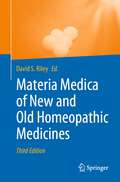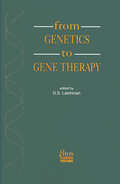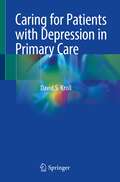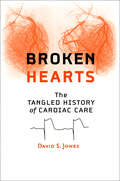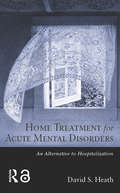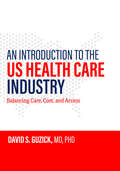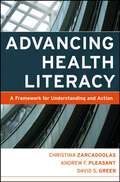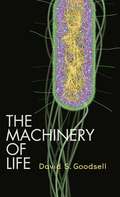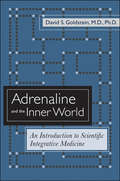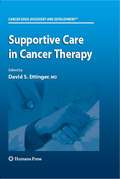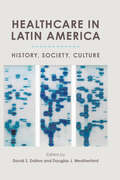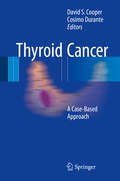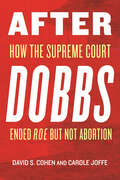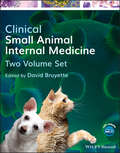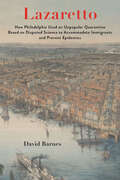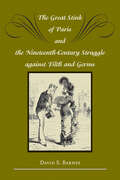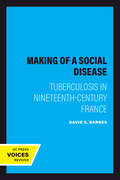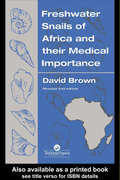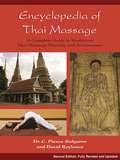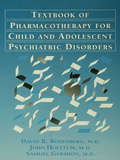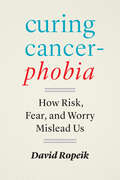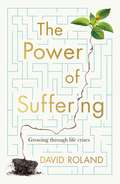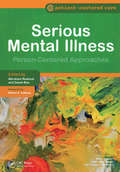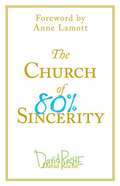- Table View
- List View
Materia Medica of New and Old Homeopathic Medicines
by David S. RileyDavid S. Riley’s interest in the research and subsequently the history and methodology of homeopathic drug provings began with his medical school training in 1979 and a residency in Internal Medicine. He was exposed to homeopathy in 1988 followed by study at the Hahnemann College of Homeopathy in Albany, California. He has investigated the interplay between contemporary research methods and the research methods associated with homeopathic drug provings. Dr Riley has developed research tools for data collection, symptom selection criteria and blinding; primarily to address the risk of bias.The homeopathic drug provings published here are the result of this work. For the 3rd edition twelve homeopathic drug provings, conducted by a number of internationally renowned proving directors, have been added. These homeopathic drug provings all follow good clinical practice (GCP) research guidelines and incorporate the guidelines suggested by Dr Samuel Hahnemann more than 200 years ago.
From Genetics to Gene Therapy: The Molecular Pathology of Human Disease
by David S. LatchmanDistinguished scientists provide an overview of the molecular pathology of human disease. Each chapter provides an analysis of the molecular biological approaches to individual diseases, such as leukaemia, cardiovascular disease and cancer. To celebrate the formation of the new Department a I-day meeting entitled 'From Genetics to Gene Therapy' was held on 14 December 1992, at which a large audience was inspired by talks from a variety of distinguished speakers. This volume is based on the meeting and contains contributions provided by the invited speakers.
Caring for Patients with Depression in Primary Care
by David S. KrollDepression is the leading cause of disability in the United States, and the traditional framework for managing depression within a psychiatry practice—i.e., a single psychiatrist treating a single patient for up to an hour per week—comes up painfully short at the level of serving the population even if it can be highly effective for individuals. At the same time, the non-systematic way in which most patients identify the need to see a specialty provider in behavioral health leaves many stranded, regardless of how complex their needs are. Primary care is now often considered the “de facto mental health system” in the United States, and primary care providers have been charged with the impossible task of making up for the dearth of psychiatric specialty providers and somehow correcting the many inequities in access to care that remain. Primary care providers shouldn’t have to do this alone. Help can come in many forms, of course, and some primary care practices are lucky enough to have a consulting psychiatrist on-site, available to answer any questions that come up and see patients directly when they need an expert opinion. This is exactly what David S Kroll, MD, an Associate Vice Chair in the Department of Psychiatry at Brigham and Women’s Hospital in Boston and an Assistant Professor at Harvard Medical School, does for a primary care practice that serves more than 17,000 patients with a wide range of medical, social, and psychiatric problems. But most primary care practices don’t have this resource. This book replicates the expertise of a consulting psychiatrist in a concise volume that primary care providers can pull off their shelves whenever they have a question about managing depression. It ensures that no one has to do this on their own. Managing Depression in Primary Care contains fourteen chapters that anticipate the questions, problems, and practical challenges that are most likely to come up when managing depression in primary care. It covers the basic skills that are needed for treating depression when it occurs in a vacuum, but it also provides practical guidance on treating depression in the real world—where it will inevitably be complicated by other factors. It also covers important associated topics including suicide, substance use, and disability.
Broken Hearts: The Tangled History of Cardiac Care
by David S. JonesA history illustrating the complexity of medical decision making and risk.Still the leading cause of death worldwide, heart disease challenges researchers, clinicians, and patients alike. Each day, thousands of patients and their doctors make decisions about coronary angioplasty and bypass surgery. In Broken Hearts David S. Jones sheds light on the nature and quality of those decisions. He describes the debates over what causes heart attacks and the efforts to understand such unforeseen complications of cardiac surgery as depression, mental fog, and stroke.Why do doctors and patients overestimate the effectiveness and underestimate the dangers of medical interventions, especially when doing so may lead to the overuse of medical therapies? To answer this question, Jones explores the history of cardiology and cardiac surgery in the United States and probes the ambiguities and inconsistencies in medical decision making. Based on extensive reviews of medical literature and archives, this historical perspective on medical decision making and risk highlights personal, professional, and community outcomes.
Home Treatment for Acute Mental Disorders: An Alternative to Hospitalization
by David S. HeathIn the U.S., when a patient is in need of rigorous psychiatric care, the first step is hospitalization. However, elsewhere in the world, psychiatric home treatment is proposed as an alternative. Model programs in Canada and the United Kingdom are publicly administered by community health agencies or teaching hospitals. Home Treatment for Acute Mental Disorders provides a review of the literature on home care and describes working programs around the world. This timely volume reviews treatment plans for different disorders with case illustrations, explains the administration of a PHC program and offers guidelines to case workers. It will be of interest to psychiatrists and policy makers working on the issue of patient hospitalization.
An Introduction to the US Health Care Industry: Balancing Care, Cost, and Access
by David S. GuzickWhy does US health care have such high costs and poor outcomes? Dr. David S. Guzick offers this critique of the American health care industry and argues that it could work more effectively by rebalancing care, cost, and access.For decades, the United States has been faced with a puzzling problem: Despite spending much more money per capita on health care than any other developed nation, its population suffers from notoriously poorer health. In comparison with 10 other high-income nations, in fact, the US has the lowest life expectancy at birth, the highest rates of infant and neonatal mortality, and the most inequitable access to physicians when adjusted for need. In An Introduction to the US Health Care Industry, Dr. David S. Guzick takes an in-depth look at this troubling issue. Bringing to bear his unique background as a physician, economist, former University of Rochester medical school dean, and former president of the University of Florida Health System, Dr. Guzick shows that what we commonly refer to as the US health care "system" is actually an industry forged by a unique collection of self-interested and disjointed stakeholders. He argues that the assumptions underlying well-functioning markets do not align with health care. The resulting market imperfections, combined with entrenched industry stakeholders, have led to a significant imbalance of care, cost, and access.Using a nontechnical framework, Dr. Guzick introduces readers to the economic principles behind the function—and dysfunction—of our health care industry. He shows how the market-based approach could be expected to remedy these problems while detailing the realities of imperfections, regulations, and wealth inequality on those functions. He also analyzes how this industry developed, presenting the conceptual underpinnings of the health care industry while detailing its history and tracing the creation and entrenchment of the current federation of key stakeholders—government, insurance companies, hospitals, doctors, employers, and drug and device manufacturers. In the final section of the book, Dr. Guzick looks to the future, describing the prevention, innovation, and alternative financing models that could help to rebalance the priorities of care, cost, and access that Americans need.An online supplement on COVID-19 is available, as is a discussion guide for instructors. To access this supplemental material, please visit www.jhupbooks.press.jhu.edu.
Advancing Health Literacy
by Andrew Pleasant David S. Greer Christina ZarcadoolasAdvancing Health Literacy addresses the crisis in health literacy in the United States and around the world. This book thoroughly examines the critical role of literacy in public health and outlines a practical, effective model that bridges the gap between health education, health promotion, and health communication. Step by step, the authors outline the theory and practice of health literacy from a public health perspective. This comprehensive resource includes the history of health literacy, theoretical foundations of health and language literacy, the role of the media, a series of case studies on important topics including prenatal care, anthrax, HIV/AIDS, genomics, and diabetes. The book concludes with a series of practical guidelines for the development and assessment of health communications materials. Also included are essential techniques needed to help people make informed decisions, advocate for themselves and their community, mitigate risk, and live healthier lives.
The Machinery of Life
by David S. GoodsellThe Machinery of Life is a journey into the sub-microscopic world of molecular machines. Readers are introduced to the types of molecules built by cells, including proteins, nucleic acids, lipids, and polysaccharides; then, in a series of full-color "watercolor" illustrations, which show a portion of a living cell magnified by 1,000,000 times, the reader is guided through the interior world of cells. The book explores the ways in which molecules work in concert to perform the processes of living, and how vitamins, viruses, poisons, and drugs each have their effects on the molecules in our bodies. The book is a fascinating introduction to biochemistry for the non-specialist, and combines a lucid text with an abundance of drawings and computer graphics that present the world of cells and their components in a truly unique way. This new edition has been updated to include the many major advances of the past decade, and is richly illustrated in full color throughout.
Adrenaline and the Inner World: An Introduction to Scientific Integrative Medicine
by David S. GoldsteinThis accessible work is the first in more than seventy-five years to discuss the many roles of adrenaline in regulating the "inner world" of the body. David S. Goldstein, an international authority and award-winning teacher, introduces new concepts concerning the nature of stress and distress across the body's regulatory systems. Discussing how the body's stress systems are coordinated, and how stress, by means of adrenaline, may affect the development, manifestations, and outcomes of chronic diseases, Goldstein challenges researchers and clinicians to use scientific integrative medicine to develop new ways to treat, prevent, and palliate disease. Goldstein explains why a former attorney general with Parkinson disease has a tendency to faint, why young astronauts in excellent physical shape cannot stand up when reexposed to Earth's gravity, why professional football players can collapse and die of heat shock during summer training camp, and why baseball players spit so much. Adrenaline and the Inner World is designed to supplement academic coursework in psychology, psychiatry, endocrinology, cardiology, complementary and alternative medicine, physiology, and biochemistry. It includes an extensive glossary.
Supportive Care in Cancer Therapy
by David S. EttingerIn this volume, Supportive Care in Cancer Therapy, a part of the Cancer Drug Discovery and Development series, the contributors provide an up-to-date, concise review of specific consequences of cancer and its treatment. The book will assist those who care for the cancer patient to better understand all of the consequences of cancer and its treatment. In addition, the reader will gain thoughtful information on the care of the older patient as well as the dying patient.
Healthcare in Latin America: History, Society, Culture
by David S. Dalton and Douglas J. WeatherfordIllustrating the diversity of disciplines that intersect within global health studies, Healthcare in Latin America is the first volume to gather research by many of the foremost scholars working on the topic and region in fields such as history, sociology, women’s studies, political science, and cultural studies. Through this unique eclectic approach, contributors explore the development and representation of public health in countries including Argentina, Bolivia, Brazil, Chile, Colombia, Cuba, Ecuador, El Salvador, Guatemala, Mexico, Nicaragua, Puerto Rico, and the United States. They examine how national governments, whether reactionary or revolutionary, have approached healthcare as a means to political legitimacy and popular support. Several essays contrast modern biomedicine-based treatment with Indigenous healing practices. Other topics include universal health coverage, childbirth, maternal care, forced sterilization, trans and disabled individuals’ access to care, intersexuality, and healthcare disparities, many of which are discussed through depictions in films and literature. As economic and political conditions have shifted amid modernization efforts, independence movements, migrations, and continued inequities, so have the policies and practices of healthcare also developed and changed. This book offers a rich overview of how the stories of healthcare in Latin America are intertwined with the region’s political, historical, and cultural identities.Contributors: Benny J. Andrés, Jr. | Javier Barroso | Katherine E. Bliss | Eric D. Carter | David S. Dalton | Carlos S. Dimas | Sophie Esch | Renata Forste | David L. García León | Javier E. García León | Jethro Hernández Berrones | Katherine Hirschfeld | Emily J. Kirk | Gabriela León-Pérez | Manuel F. Medina | Christopher D. Mellinger | Alicia Z. Miklos | Nicole L. Pacino | Douglas J. Weatherford Publication of this work made possible by a Sustaining the Humanities through the American Rescue Plan grant from the National Endowment for the Humanities.
Thyroid Cancer
by David S. Cooper Cosimo DuranteComprised exclusively of clinical cases covering the diagnosis and treatment of thyroid cancer and related clinical issues, this concise, practical casebook will provide clinicians in endocrinology and oncology with the best real-world strategies to properly manage the various forms of thyroid cancer that they may encounter. Each chapter is a case report, written by recognized experts, that opens with a unique clinical presentation, followed by a description of the diagnosis, assessment and therapy, as well as the case outcome, literature review, clinical pearls and pitfalls, and bibliography. All recommendations are based on evidence-based clinical practice guidelines and recent literature. Cases included illustrate treatment for both low and high risk differentiated thyroid cancer, including surgical approaches, radioiodine therapy, and novel chemotherapies and targeted therapies, as well as postoperative follow-up and special issues. Additional cases demonstrate the management of medullary thyroid cancer, thyroid lymphoma and anaplastic thyroid cancer. Pragmatic and reader-friendly, Thyroid Cancer: A Case-Based Approach will be an excellent resource for clinical endocrinologists and oncologists, endocrine fellows, residents and students alike.
After Dobbs: How the Supreme Court Ended Roe but Not Abortion
by David S. Cohen Carole JoffeHow hard-working individuals have kept abortion afloat in the wake of Roe v. Wade&’s destruction, and the continued help needed if we want to sustain itWhen the Supreme Court overturned Roe v. Wade in June 2022, many feared it meant the end of abortion access in the United States. Yet the courageous work of people on the ground has allowed abortion to survive post-Dobbs in ways that no one predicted.In After Dobbs, law professor David S. Cohen and sociologist Carole Joffe interview 24 people across all different fields in abortion and in different state political environments to uncover how the abortion providing community and its allies prepared for, and then responded to this momentous event. Taking place across three intervals throughout 2022—pre-Dobbs in early 2022, right after Dobbs, and then six months later—these interviews showcase how nimble thinking on the part of providers, growth and new delivery models of abortion pills, and the never-ending work of those who help with abortion travel and funding have ensured most people who want them are still getting abortions, even without Roe.But, as much as this is cause for celebration, the work required to make abortion possible is difficult and costly—in time, money, and emotion. There may soon come a time when the overturning of Roe means a much more severe decline in the number of people able to obtain the abortions they seek. But because of the work of the people in this book and those like them, even though Roe is dead, abortion is not . . . yet.
Clinical Small Animal Internal Medicine
by David S. BruyetteClinical Small Animal Internal Medicine is a comprehensive, practical reference designed to meet the needs of veterinary practitioners and students alike. Covering all aspects of small animal internal medicine, this innovative guide provides clinically relevant material, plus podcasts and continual updates online. Concise, identically-formatted chapters allow readers to quickly find the most essential information for clinical veterinary practice. Contributions from academic and clinical experts cover general medicine subjects, including patient evaluation and management, critical care medicine, preventative care, and diagnostic and therapeutic considerations. Topics relevant to daily clinical practice are examined in detail, ranging from endocrine, cardiovascular, respiratory, and infectious disease to oncology, dermatology, metabolic orthopedic disease, gastroenterology, and hepatology. A companion website features podcasts and updated information. An important addition to the library of any practice, this clinically-oriented text: Presents complete, practical information on small animal internal medicine Provides the background physiology required to understand normal versus abnormal in real-world clinical settings Includes general medicine topics not covered in other internal medicine books Focuses on information that is directly applicable to daily practice Features podcasts and continual updates on a companion website Carefully tailored for the needs of small animal practitioners and veterinary students, Clinical Small Animal Internal Medicine is an invaluable, reader-friendly reference on internal medicine of the dog and cat.
Lazaretto: How Philadelphia Used an Unpopular Quarantine Based on Disputed Science to Accommodate Immigrants and Prevent Epidemics
by David S. BarnesHow the controversial practice of quarantine saved nineteenth-century Philadelphia after a series of deadly epidemics.In the 1790s, four devastating yellow fever epidemics threatened the survival of Philadelphia, the nation's capital and largest city. In response, the city built a new quarantine station called the Lazaretto downriver from its port. From 1801 to 1895, a strict quarantine was enforced there to protect the city against yellow fever, cholera, typhus, and other diseases. At the time, the science behind quarantine was hotly contested, and the Board of Health in Philadelphia was plagued by internal conflicts and political resistance. In Lazaretto, David Barnes tells the story of how a blend of pragmatism, improvisation, and humane care succeeded in treating seemingly incurable diseases and preventing further outbreaks.Barnes shares the lessons of the Lazaretto through a series of tragic and inspiring true stories of people caught up in the painful ordeal of quarantine. They include a nine-year-old girl enslaved in West Africa and freed upon arrival in Philadelphia, an eleven-year-old orphan boy who survived yellow fever only to be scapegoated for starting an epidemic, and a grieving widow who saved the Lazaretto in the midst of catastrophe. Spanning a turbulent century of immigration, urban growth, and social transformation, Lazaretto takes readers inside the life-and-death debates and ordinary heroism that saved Philadelphia when its survival as a city was at stake. Amid the controversy and tragedy of the COVID-19 pandemic, this surprising reappraisal of America's historic struggle against deadly epidemics reminds us not to neglect old knowledge and skills in our rush to embrace the new.
The Great Stink of Paris and the Nineteenth-Century Struggle against Filth and Germs
by David S. BarnesExplores the scientific and social factors that continue to influence the public's lingering uncertainty over how disease can—and cannot—be spread.Late in the summer of 1880, a wave of odors enveloped large portions of Paris. As the stench lingered, outraged residents feared that the foul air would breed an epidemic. Fifteen years later—when the City of Light was in the grips of another Great Stink—the public conversation about health and disease had changed dramatically. Parisians held their noses and protested, but this time few feared that the odors would spread disease. Historian David S. Barnes examines the birth of a new microbe-centered science of public health during the 1880s and 1890s, when the germ theory of disease burst into public consciousness. Tracing a series of developments in French science, medicine, politics, and culture, Barnes reveals how the science and practice of public health changed during the heyday of the Bacteriological Revolution.Despite its many innovations, however, the new science of germs did not entirely sweep away the older "sanitarian" view of public health. The longstanding conviction that disease could be traced to filthy people, places, and substances remained strong, even as it was translated into the language of bacteriology. Ultimately, the attitudes of physicians and the French public were shaped by political struggles between republicans and the clergy, by aggressive efforts to educate and "civilize" the peasantry, and by long-term shifts in the public's ability to tolerate the odor of bodily substances.
The Great Stink of Paris and the Nineteenth-Century Struggle against Filth and Germs
by David S. BarnesThe scientific and social history surrounding the 1880 incident of a foul odor in Paris and the development of public health culture that followed.Late in the summer of 1880, a wave of odors enveloped large portions of Paris. As the stench lingered, outraged residents feared that the foul air would breed an epidemic. Fifteen years later—when the City of Light was in the grips of another Great Stink—the public conversation about health and disease had changed dramatically. Parisians held their noses and protested, but this time few feared that the odors would spread disease.Historian David S. Barnes examines the birth of a new microbe-centered science of public health during the 1880s and 1890s, when the germ theory of disease burst into public consciousness. Tracing a series of developments in French science, medicine, politics, and culture, Barnes reveals how the science and practice of public health changed during the heyday of the Bacteriological Revolution.Despite its many innovations, however, the new science of germs did not entirely sweep away the older “sanitarian” view of public health. The longstanding conviction that disease could be traced to filthy people, places, and substances remained strong, even as it was translated into the language of bacteriology. Ultimately, the attitudes of physicians and the French public were shaped by political struggles between republicans and the clergy, by aggressive efforts to educate and “civilize” the peasantry, and by long-term shifts in the public’s ability to tolerate the odor of bodily substances.“A well-developed study in medically related social history, it tells an intriguing tale and prompts us to ask how our own cultural contexts affect our views and actions regarding environmental and infectious scourges here and now.” —New England Journal of Medicine“Both a captivating story and a sophisticated historical study. Kudos to Barnes for this valuable and insightful book that both physicians and historians will enjoy.” —Journal of the American Medical Association
The Making of a Social Disease: Tuberculosis in Nineteenth-Century France
by David S. BarnesIn this first English-language study of popular and scientific responses to tuberculosis in nineteenth-century France, David Barnes provides a much-needed historical perspective on a disease that is making an alarming comeback in the United States and Europe. Barnes argues that French perceptions of the disease—ranging from the early romantic image of a consumptive woman to the later view of a scourge spread by the poor—owed more to the power structures of nineteenth-century society than to medical science. By 1900, the war against tuberculosis had become a war against the dirty habits of the working class.Lucid and original, Barnes's study broadens our understanding of how and why societies assign moral meanings to deadly diseases.
Freshwater Snails Of Africa And Their Medical Importance
by David S BrownThe first half of this book is primarily a systematic survey of the snails, beginning with glossaries, keys for identification to genera and a checklist of species. This is followed by a synopsis of species, with brief notes on ecology, distribution and parasites. Relationships are then described between snails and schistosomes and with other paras
Encyclopedia of Thai Massage
by David Roylance C. Pierce SalgueroDrawing from Thai history, cultural studies, Buddhist religion, and yogic practices, as well as a modern understanding of anatomy and physiology, this guidebook bridges the gap between theory and practice while presenting bodywork as it is understood in Thailand-as a therapeutic medical science. Presenting detailed analysis of each step in a Thai massage routine, the history, spiritual traditions, and ethical codes are offered in an engaging, informal style. Numerous photographs and diagrams illustrate the variety of techniques used, and examples of routines for treating specific disorders are discussed. Updated with new layout, photos, and expanded text, this exhaustive handbook is complete with a section on the main energy meridians and diagrams of acupressure points, making it the perfect tool to accompany anyone studying this popular healing modality.
Pocket Guide For The Textbook Of Pharmacotherapy For Child And Adolescent psychiatric disorders
by David RosenbergThis is a quick-reference guide for psychiatrists, therapists, social workers, and other practitioners about each group of medications. This guide, which discusses the use of psychiatric drugs in patients under 18, accompanies the author team's complete book Textbook of Pharmacotherapy for Child and Adolescent Psychiatric Disorders.; Clinical indications, dosage guidelines, side-effects, common drug interactions and most tables are retained and updated in this guide. the guide provides the reader with the practical guidelines to safely and effectively prescribe medication.
The Power Of Suffering
by David RolandThe Power of Suffering is psychologist David Roland&’s personal investigation into the nature of human suffering. When our world is turned upside down, what does it do to us, how do we survive it, and, most importantly, how can we grow as a result? David takes the lived experience of eleven incredible people and follows them along each step of their journey from crisis through to acceptance and triumph. Within each story, David draws on his own experience of life-altering trauma and clinical research to offer insights we all can gain from. Each life story examined is a moving testimony of the human spirit&’s ability to rise and rise again – an executive tragically loses his family in a car crash and finds healing in the rehabilitation of wildlife, a teenage victim of domestic violence becomes a fierce advocate for abused women and brain-injured youth, a football superstar overcomes bigotry and dyslexia to forge a career in acting, a mother experiences the aching depth of love lost after her teenage child&’s life is tragically cut short. These are but a few of the intimately told stories, all pointing to a path through the storm and beyond.The Power of Suffering is a revelatory account of how the darkest night can lead to the most profound dawn.
Serious Mental Illness: Person-Centered Approaches
by David Roe Abraham RudnickPractical and evidence-based, this unique book is the first comprehensive text focused on person-centered approaches to people with serious mental illness such as schizophrenia and bipolar disorder. It reflects a range of views and findings regarding assessment, treatment, rehabilitation, self-help, policy-making, education and research. It is highly recommended for all healthcare professionals, students, researchers and educators involved in general practice, psychiatry, nursing, social work, clinical psychology and therapy. Healthcare service providers, and policy makers and shapers, will find the book's wide-ranging, multi-professional approach enlightening. 'Serious Mental Illness reflects a continued distancing from the outmoded and unsubstantiated belief that people with severe mental illnesses could not recover, and that they would respond positively only to goals and treatment plans chosen, designed and implemented by providers in order to prevent their further deterioration. Anyone with an interest in the concept of person-centered approaches will discover new ideas in this book. Indeed, anyone with an interest in person-centered approaches has to read this book. Not only is it the first such book on person-centered approaches, but it will serve as the gold standard in this topic area for years to come.' William A Anthony, in the Foreword
The Church of 80% Sincerity
by Anne Lamott David RocheThe Church of 80% Sincerity shares the inspiring, poignant, wickedly funny, and sometimes heartbreaking story of motivational speaker David Roche's journey from shame to self-acceptance. Born with a severe facial deformity, David's life has been anything but easy. Still, over time, he's learned to accept his gifts as well as his flaws, and to see that, sometimes, they are one and the same. In this compelling book, he shares his hard-earned lessons, providing an irresistible and unforgettable glimpse of his (and everyone's) inner beauty and offering profound encouragement in dealing with whatever life brings.
